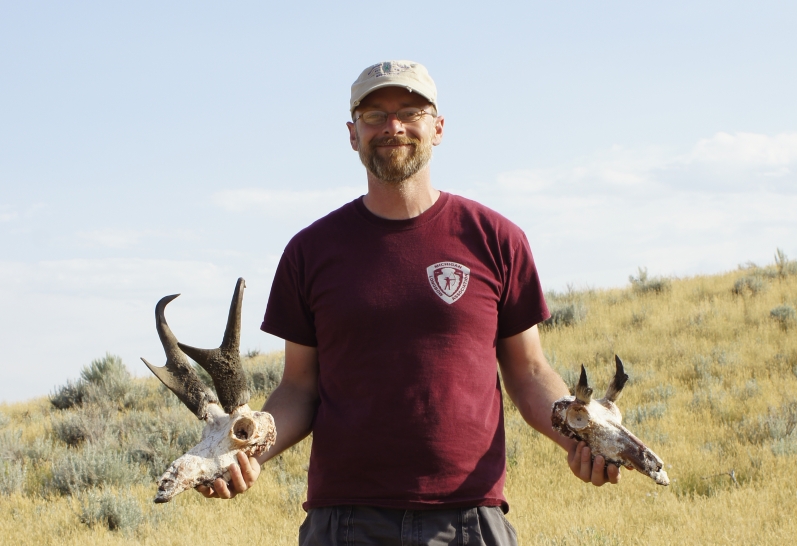Growing up, I hunted to help feed my family. If we didn’t catch fish or kill game there wasn’t enough money in the budget to buy much meat. There were many more deer and other species of big game animals within the borders of Montana than humans at that time, probably still true in spite of the population explosion of the 1990s and 2000s.
A deer tag was $8 and gas was around a dollar a gallon. With a lucky trip a family might punch multiple tags on a single tank of gas. Here I am at twelve with a buck that dressed out over 200 pounds with a mature doe behind him.

For $16 in tags plus $12 in gas we collected over 100 pounds of lean healthy all organic meat before noon that day. We also cast most of the bullets we’d shoot and all our fishing sinkers out of lead from the junk yard to cut down on expenses.
I was just thinking back as I’m writting this and I realized that this picture was taken just 3 weeks after the “Black Monday” stock market crash of 1987. Now I remember the big push to fill the freezer with deer and catch as many salmon as allowed to smoke for the winter. A working class family in a hard economy is the reason I learned how to hunt, but I gave it up.
Some years later I had a career started, and with a little excess money in the paycheck, but no vacation time, it became far easier to buy meat at the store than to forage for it on the hoof. I only hunted one season between 1992 and 2010 because I simply didn’t NEED to. Even as I first became aware of the problems in our food system around 2008, it was easier to buy free ranging organic meat directly from a farmer than to endeavor to harvest wild game. I actually have no problem with this at all. Any consumer of meat who doesn’t hunt should go directly to the farm with the animals and talk to the farmers and look at the animals. If you want to eat meat and are opposed to hunting, this is what you should be doing. For many, many years I ate most vegetables from a CSA share, probably the best way to get organic GMO free vegetables.
Around this time, three things happened. These three things are the reason I chose to hunt.
First, I read Omnivore’s Dilemma. That really got my wheels turning. Next I read All Flesh Is Grass and I started studying integrative medicine and the benefits of wild meat over anything raised in a pen. I was well versed when Food Inc hit the stands in 2009. Getting really educated on the CFO feeding operations and slaughterhouse practices nearly drove me to being a vegan, but that isn’t my path.
Second event,this one a little more whimsical. A chef friend called me to his restaurant to eat some wild boar loin. It was some sort of special deal and they weren’t allowed to sell it or put it on the menu, but they could give it away (intended for management and staff.) I savored every morsel of the finest meat I’d ever eaten. To this day, it’s one of the greatest meals of my life. Many months later I got to enjoy wild boar shanks. I started searching for a way to buy wild hog meat and was crushed to find out that selling that meat was illegal. Realistically, the only way to get the meat was to kill the feral hogs for yourself.
Finally, I got cancer. Given all of my studies in the previous few years, I was quick to understand the link between our industrial food systems and the alarming rate of cancer occurrence in our country. Since I was already a Type 1 Diabetic, I felt that I was already living on borrowed time.
So nearly twenty years after I’d quit hunting out of financial necessity, I chose to start hunting out of moral necessity. In short
- Concentrated Feedlot Operations are horrible, no animal should endure such a life as commercial meat business has standardized on.
- I do believe I can kill an animal FAR more humanely than a industrial slaughterhouse.
- Since I hunt only invasive/feral animals or “Least Concern” animals it means that I’m actually doing an important job in maintaining the balances in the herds of wild animals.
- I have either personally eaten every pound of meat of every animal I’ve killed, or I have on occasion gifted it to people who wanted to eat it. More on this in an upcoming blog post.
Since I chose to eat meat, this is the most conscious and moral way of doing so that I can imagine. If I can think of a better way I will pursue that. Until that time, I will continue to harvest my own meat and process it myself.
As a final note, I’ve told vegan friends in the past that I admire their consciousness about our food systems and their extraordinary efforts in maintaining a healthy diet without animal protein. I still stand by that 100%. I think I have more in common with them than with anyone who unknowingly walks into a super market and buys ground beef wrapped in plastic.
This post might not be popular among hunting peers, but most of what the hunting media publishes isn’t popular with me.



